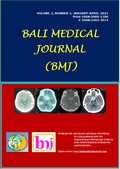HIGH SERUM C-REACTIVE PROTEIN AS PREDICTOR OF SYSTEMIC INFLAMATORY RESPONES SYNDROME IN SEVERE HEAD INJURY PATIENTS
Abstract
Objectives: Despite the fact that many studies have shown that the role of high sensitivity C-reactive protein (Hs-CRP) in inflammation diseases, the role of this molecule in severe head injury (SHI) has not been understood clearly. Severe head injury was defined as a trauma to the head frequently found in Emergency Units where some cases result in mortality. Severe head injury was defined as Glasgow Coma Scale (GCS) score between 3 and 8. Based on this data, we felt that it was important to determine the role of Hs-CRP as a predictor of SIRS in SHI patients. Method: This was a Cohort prospective study about the role of serum Hs-CRP as a predictor for Systemic inflammatory response syndrome (SIRS) in SHI patients at Sanglah General Hospital, Bali-Indonesia from August 2012 to February 2013. A number of 60 patients fulfilled the inclusive criteria. The data were analyzed descriptively to show the characteristics of the samples and was analyzed using univariate and multivariate analysis to determine the predictor factors for SIRS in SHI patients. A confidence interval of 95% (p < 0.05) was applied. Results: From 60 samples collected, there were 43 males (71.7%) and 17 females (28.3%), the majority age of the samples were 20-40 years old (21 samples, 35%). On the first day 49 samples (81.6%) had elevated serum Hs-CRP levels. Fifty seven samples (95%) had SIRS, and only 3 samples (5%) did not have SIRS. Bivariate analysis between Hs-CRP level and SIRS was significant (p = 0.001). Multivariate analysis showed that pneumonia and high Hs-CRP serum levels were significant predictor factors for SIRS in SHI patients. Conclusion: High serum Hs-CRP levels could be used as a reliable predictor factor for SIRS in SHI patients.


